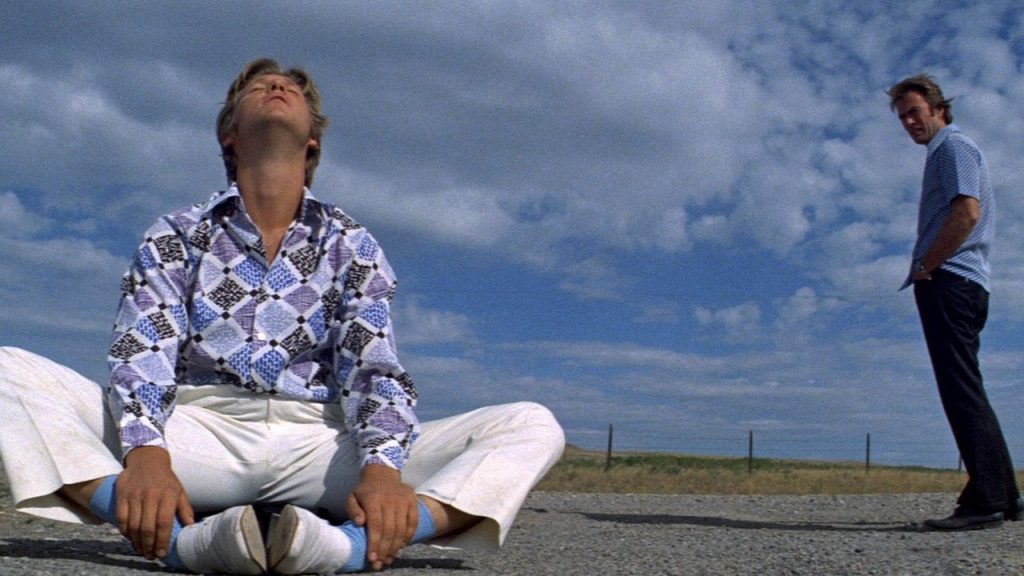Jeff Bridges could not convince writer-director Michael Cimino that he’d hired the wrong Lightfoot. From where he was standing, three years past his Oscar-nominated arrival in The Last Picture Show, there was precious little of him in the fun, fancy-free character. Pleas for unemployment went unheeded but he was still unconvinced, asking for more takes, more chances to figure this guy out. Every time, Cimino deferred to “the boss,” the man keeping the meter running, the same who first wanted to direct Thunderbolt and Lightfoot and just so happened to be the biggest box office attraction in the world.
And every time, Clint Eastwood, the filmmaker who would eventually deny Matt Damon a second crack at his South African accent because he didn’t want to waste the crew’s time, would say, “Give the kid another one.” It’s a small act of compassion that 50 years of legend has made mythic. It’s also par for the course on Thunderbolt and Lightfoot, an off-kilter heist picture snuck between Dirty Harrys that remains Clint’s most romantic vehicle set beyond Madison County.
Laying low as a priest among the amber waves, Thunderbolt wills his better half into existence with a verse from Isaiah about pleasant apocalypse: “The wolf shall dwell with the lamb, the leopard shall lie down with the kid.” Enter Lightfoot in black leather pants and a white Pontiac Firebird that he didn’t bother paying for. When they meet, it’s penny-ante kismet, one running from a slovenly hitman, the other from slow police.
The first thing Lightfoot notices about the hitchhiker is his bad disguise. First thing Thunderbolt notices about the wheelman are his blue eyes. It’s no fluke observation. When the duo eventually steals a car with a fresh wardrobe in the back, they opt for complementary patterns of cornflower. Later, when the big score calls for Bugs Bunny drag, Lightfoot keeps his dress coordinated.
“We gotta stop meeting like this,” coos Lightfoot, no sign of the minute-old agony over an attempted farewell from his new partner. “People are gonna talk.” Whatever they mean to each other, they never admit it, if they even understand it. Confirmations of something deeper than merry-men camaraderie show in small, unadorned moments from Thunderbolt. Letting the kid name him after his newspaper alias, blowing their petty cash on a round of ice cream, spilling beans on the same stashed loot that almost got him killed.
Lightfoot is less comfortable with the unknown, admitting only by contradiction. He barks at every woman that walks by, sometimes literally. Waitresses. Pedestrians. Motorcyclists. But his dalliances always end in a loud dot-dot-dot. When he brings back two ladies to their hideout, it’s Thunderbolt who gets a sex scene and bored orgasm. When he asks how his cocky cohort’s night went, a night neither seen nor heard, Lightfoot cryptically demurs, “Red-headed women are bad luck.” Despite a lonesome housewife standing naked in front of him, the proud Casanova only takes the opportunity to tease Cro-Magnon accomplice Red Leary with the story.
Those tables eventually turn when Thunderbolt hatches a plan that calls for Lightfoot to distract a guard with whatever feminine wiles he can muster. In an instant, he’s no longer Jack-the-Lad, but a boy who lost badly at truth-or-dare. Red wastes no time sticking him in the soft: “Don’t forget to shave.”
Most of Thunderbolt and Lightfoot takes place in a Boy’s Own world. The four hoods – ‘bolt, ‘foot, Red, and sidekick Eddie Goody – fit neatly into recess archetypes. Life begins and ends with a one-room schoolhouse. Weeks spent bankrolling the heist with odd jobs like landscaping and ice cream delivery might as well be summer vacation. Their grand scheme hinges on sneaking into a drive-in movie. Crime is rosily abstract, Tom Sawyer stuff, like boosting a Plymouth from a kook who keeps rabbits in his trunk. Homosexuality is kept out of sight, but never far out of mind. Red, straight male id incarnate, speaks exclusively in homoerotic threats like, “Drop your cocks,” or, “I want your ass.” Thunderbolt’s machine shop coworker can’t stop laughing about the time he bullied a loser into grabbing his penis. But hey, it’s all in good fun.
Until the Boy’s Own rules stop applying. In a rage over their sloppy getaway, Red kicks Lightfoot into the dirt and keeps kicking. In any other movie, that’s three scenes of bruise make-up. In Cimino’s, it’s terminal. Lightfoot dies slowly on his feet, even as they find the loot, even as Thunderbolt buys him his dream Caddy in cash.
“I don’t think of us as criminals, you know?” says the kid, barely able to keep a celebratory cigar in his mouth, let alone form the words. They’re not friends, at least by Red’s definition – someone you trust enough to kill. But before either can fill in the blank, Lightfoot dies and Thunderbolt breaks his cigar in eulogy. Whatever they were besides criminals, there’s no word for it now.So wonders Paul Williams over the end credits, “Where does a fool go when there’s no one left to listen?” Thunderbolt and Lightfoot, a deceptively tender love story from the most infamously slow director in history and starring the most infamously fast, doesn’t have the answer to that riddle. But it does have Clint Eastwood giggling as Jeff Bridges tries to smear raccoon shit on him, and he’s never looked giddier.
“Thunderbolt and Lightfoot” is now streaming on Amazon Prime Video.

